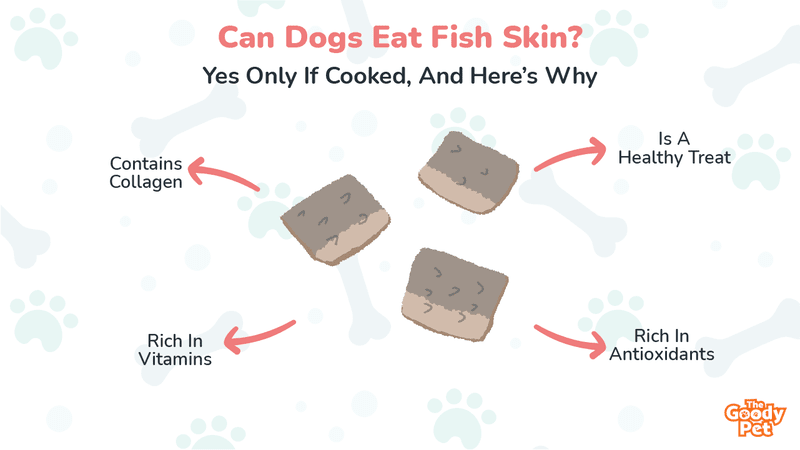If you have ever gone through the ingredients of your dog’s food from different dog food brands sold in stores, you probably know that fish is a frequent item on the menu. However, just because fish is an ingredient in dog food doesn’t mean that fish skins are safe for dogs to consume. So, are fish skins good for dogs?
Yes, dogs can safely consume fish skin. It is an amazing source of omega oils for dogs and gives many health benefits. They are sometimes dehydrated to form treats shaped in cubes or strips. However, fish skins are not the same. They are packaged and processed in different forms, and you might wonder which ones are the best for your dog.
While you can make these fishy treats at home, it is a bit challenging since you have to separate the skins from the fish. Therefore, it is advisable to find a supplier who has well-processed products. If you’re looking to add fish skin to your dog’s diet, here is what you need to know.
Can Dogs Eat Fish Skin?

Yes! Dogs can eat fish. It is one of the essential ingredients in balanced commercial dog foods or a home-cooked diet for your dog. In addition, it is an excellent source of protein, and this is why it is considered a novel protein in most commercial prescription diets.
Furthermore, fish skins are relatively low in fats and quite easy to digest when cooked. This is beneficial for dogs with medical conditions like food allergies, indigestion, or other dietary conditions.
Although fish skins are very healthy for dogs, they should not be their main meal on a daily basis. Instead, fish skins should only contribute to the dog’s daily treats. Like everything else, fish skins should be taken in moderation.
What Are Fish Skins?
In simple terms, fish skins are just skins from fish that have been processed to form delicious treats. The skin also includes scales; however, the thin bony scales of a modern fish, commonly referred to as cycloid and ctenoid, may lack dentine and enamel layers.
There are different ways of processing fish skins. They can either be left as a strip of fish skin or be processed to form blocks or cubes, plaited or twisted together. Sometimes, the fish skins are also ground and mixed with rice powder to create chews and treats.
Can Dogs Eat Raw Fish Skin?
No, dogs should not eat raw fish skins. They can only consume it when properly cooked, as raw fish skin may have harmful things.
For example, when dogs eat raw salmon skin, it may cause salmon poisoning, which, when left untreated, can be deadly to dogs. Furthermore, raw fish skins have harmful bacteria such as listeria, clostridium, and salmonella that may impact the health of your dog.
They can also have fish thorns that are harmful to your dog’s gastrointestinal lining and throat. While it is possible to create fish skins at home, feeding raw fish skins to your dog will only affect your dog’s health. Cooking or grilling fish skins proves a safer treatment for dogs.
Can Puppies Eat Fish Skin?
Since fish skins offer a perfect combination of proteins, vitamins, and good fats, they can be quite beneficial to puppies. Fish skins have proteins that help in the formation of strong bones and muscles.
Moreover, other important nutrients like omega-3 are great for the development of the heart, brain, and ocular health. Fish skins are also highly palatable and easy to ingest. This enables your puppy to enjoy such treats from as young as 12 weeks.
However, over-eating the skins can cause obesity as well as other health problems. This is the reason why you should find a balance in the amount of fish skin you feed your puppy. They should be fed in moderation and only as treats.
What Types Of Fish Can My Dog Eat The Skins From?

Generally, many fish types that are safe for humans can also be eaten by dogs. There are several different types of fish whose fish skins can be consumed by dogs.
These include small wild-caught or sustainably raised species whose skins and bodies have a small number of parasites and mercury.
Some of these types of fish are;
When finding the perfect fish for your dog, stay away from those raised in fish farms unless the farms follow all sustainability standards. Fish from farms, especially those that do not meet health standards, may have harmful levels of toxins and antibiotics.
What Types Of Fish Whose Skins Are Unsafe For Dogs?
Avoid large fishes that have lived for long in the wild. This is because the species have higher amounts of harmful mercury that may affect your dog’s health.
Furthermore, since they require more resources to survive, consuming such fish is less sustainable. These types of fish include;
- Tilefish
- Albacore tuna
- Shark
- King mackerel
- Swordfish
What Are The Benefits Of Fish Skin In Dogs?
Fish skin has a variety of benefits for dogs. This is why it is a great addition for dogs to eat as a regular treat or together with their meals. Apart from being highly digestible, here are some other benefits of fish skins;
Cleans Your Dog’s Teeth
Since fish skin comes with a leathery nature, it requires some effort to chew. As a result, it acts like a toothbrush and scrubs away any plaque on your dog’s teeth.
Rich In Nutrients
Fish skin is a great meal for dogs as it has vitamins and antioxidants. It also provides an ample amount of omega-3 and omega-6 fatty acids. These fatty acids reduce triglyceride levels and protect your heart.
Moreover, fish skins have collagen, which keeps the skeletal system, including bones and muscles, healthy. The protein comes in handy to support the blood vessels, hair, nails, and eyes. They are also low in saturated fats and calories, which provides more value.

Acts As A Healthy Treat
Generally, most fish skin treats are simply scaled, washed, and dried fish skins. They are free from preservatives and artificial flavors and are great for snacking as a replacement for baked treats that are not healthy.
Fish skin is also a great alternative for dogs that are allergic to either chicken or beef treats.
How Do I Feed My Dog Fish Skins?
There are two feeding methods you can use when it comes to fish skins;
Cooking
This involves using fresh fish either as a whole fish or filet form which has been properly cleaned and back. They are often grilled, baked in an oven, or steamed with no additional salt, spices, or oils.
Once the fish is properly cooked and cooled, you can go ahead to remove the skin from the fish and chop it into tiny bite-sized pieces. These pieces can either be fed as treats or be mixed with your dog’s daily meals.
Dehydrated
The dehydrated method allows you to get the full nutritional benefits without going through the hassle of cooking it. Long-lasting dehydrated fish skins are not only safe and healthy but are also a great alternative to rawhide, which is a bit challenging for dogs to digest.

How Much Fish Skin Should I Feed My Dog?
Fish skin should make a regular appearance in your dog’s diet, whether they are cooked or in dehydrated form. Since fish skins are low in saturated fat and calories, they are a healthier snack than beef or pork-derived products.
However, fish skin should only be served in moderation because too much of it can be poisonous. Before adding fish to your dog’s diet, it is advisable to consult your vet.
Are There Any Dangers Of Fish Skins?
Yes! While dried fish is safe for your dog and rarely has side effects, preparing it at home may pose a risk for it. This is because, if you’re not careful, fish skins can carry harmful bacteria and parasites.
Roundworms can be found in the muscles underneath and flukes in the skin of pork-derived fish. On the other hand, tapeworms are found in the intestines and may not be a risk if your dog only eats the skin.
To reduce these dangers, it is a great idea to dehydrate or cook fish skin thoroughly. This helps minimize the risks of infections.
Alternatives To Fish Skins
If your dog is allergic or doesn’t enjoy having fish skins, here are some of the best alternatives you can consider;
- Chicken feet: Dried chicken feet have chondroitin that helps joint formation. Although they lack omega oils as fish skins, they have a crunchy texture that improves dental health.
- Squid: This can be in the form of calamari rings or baked and dried chunks. Unlike chicken feet, these ones are high in omega oils that contribute to healthy eyes, brain, joints, brain, coat, and bones. However, they may have an extreme fishy aroma that your dog may not enjoy.
- Spats: Dried spats include tiny fish that can be eaten as a whole. Although they don’t last long like fish skin, they are a great source of omega oils as well as other nutrients.
- Prawns: Dried prawns are great treats for dogs, especially those with joint problems. This is because they have plenty of glucosamine, as well as omega-3 and omega-6 oils. They also have iodine and antioxidants that ensure proper brain and thyroid function. However, they are not very long-lasting and are quite expensive






